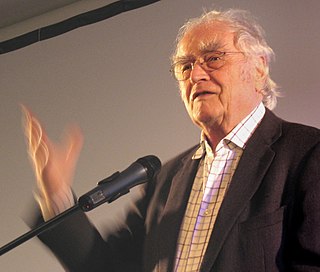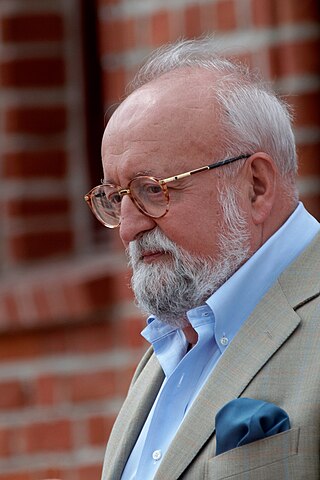Aramaic is a Northwest Semitic language that originated among the Arameans in the ancient region of Syria, and quickly spread to Mesopotamia and eastern Anatolia where it has been continually written and spoken, in different varieties, for over three thousand years. Aramaic served as a language of public life and administration of ancient kingdoms and empires, and also as a language of divine worship and religious study. Several modern varieties, namely the Neo-Aramaic languages, are still spoken.
The grammar of the German language is quite similar to that of the other Germanic languages. Although some features of German grammar, such as the formation of some of the verb forms, resemble those of English, German grammar differs from that of English in that it has, among other things, cases and gender in nouns and a strict verb-second word order in main clauses.
The German orthography reform of 1996 was a change to German spelling and punctuation that was intended to simplify German orthography and thus to make it easier to learn, without substantially changing the rules familiar to users of the language.

Martin Walser is a German writer.

The Immortal Beloved is the addressee of a love letter which composer Ludwig van Beethoven wrote on 6–7 July 1812 in Teplitz. The unsent letter is written in pencil on 10 small pages. It was found in the composer's estate following his death and is now in the Berlin State Library.
German verbs may be classified as either weak, with a dental consonant inflection, or strong, showing a vowel gradation (ablaut). Both of these are regular systems. Most verbs of both types are regular, though various subgroups and anomalies do arise; however, textbooks for learners often class all strong verbs as irregular. The only completely irregular verb in the language is sein. There are more than 200 strong and irregular verbs, but just as in English, there is a gradual tendency for strong verbs to become weak.
The main difference that sets apart German sentence structure from that of English is that German is an OV (Object-Verb) language, whereas English is a VO (verb-object) language. Additionally, German, like all Germanic languages except English, uses V2 word order, though only in independent clauses. In dependent clauses, the finite verb is placed last.
German pronouns are German words that function as pronouns. As with pronouns in other languages, they are frequently employed as the subject or object of a clause, acting as substitutes for nouns or noun phrases, but are also used in relative clauses to relate the main clause to a subordinate one.
Helvetisms are features distinctive of Swiss Standard German, that distinguish it from Standard German. The most frequent Helvetisms are in vocabulary and pronunciation, but there are also some distinctive features within syntax and orthography.

Lorenz von Bibra, Duke in Franconia was Prince-Bishop of the Bishopric of Würzburg from 1495 to 1519. His life paralleled that of Maximilian I (1459–1519), who ruled the Holy Roman Empire from 1493 to 1519, whom Lorenz served as an advisor.

"Prometheus" is a poem by Johann Wolfgang von Goethe, in which the character of the mythic Prometheus addresses God in misotheist accusation and defiance. The poem was written between 1772 and 1774 and first published in 1789 after an anonymous and unauthorised publication in 1785 by Friedrich Heinrich Jacobi. It is an important work of the Sturm und Drang movement.

The Symphony No. 8 "Lieder der Vergänglichkeit" by Krzysztof Penderecki is a choral symphony in twelve relatively short movements set to 19th and early 20th-century German poems. The work was completed and premiered in 2005. The symphony has an approximate duration of 35 minutes. Penderecki revised the symphony in 2007 by adding a few more poem settings and the piece has expanded to around 50 minutes. Although given the designation Symphony No. 8, it was not actually the final symphony Penderecki completed before his death in March 2020; the Sixth Symphony, begun in 2008, was not completed until 2017.
Joseph Schipfer was a German landowner and wine producer, today mostly known for his creation of the language Communicationssprache. He was born in Ransbach.

Josephine Brunsvik or Countess Jozefina Brunszvik de Korompa, Countess Josephine Deym, was probably the most important woman in the life of Ludwig van Beethoven, as documented by at least 15 love letters he wrote her where he called her his "only beloved", being "eternally devoted" to her and "forever faithful”. Several musicologists consider her to be the most likely recipient of the mysterious "Letter to the Immortal Beloved".

Julie "Giulietta" Guicciardi was an Austrian countess and briefly a piano student of Ludwig van Beethoven. He dedicated to her his Piano Sonata No. 14, later known as the Moonlight Sonata.

Johann Balthasar König was a German Baroque composer, especially of hymn melodies, having published a hymnal with 1,913 melodies. He was the church musician at Frankfurt's main Protestant church, the Katharinenkirche, and the town's Kapellmeister. He was also closely associated with Georg Philipp Telemann.
"Ach, wie ist's möglich dann" also known as "Treue Liebe", is a German now-traditional song. Friedrich Wilhelm Kücken (1810–1882), a German composer and conductor, claimed to have composed the tune, and that it was later modified "probably by Silcher" and given the general name Thüringer Volkslied. Its popularity helped Kücken get chosen for the court of Paul Frederick, Grand Duke of Mecklenburg-Schwerin. The tune is used at West Point, Lincoln University (Missouri) and Wake Forest University. Marlene Dietrich sang the song and it has been used in some movies, e.g. Three Comrades uses the melody throughout the film as Leitmotif for love. Similarly, Max Ophüls used it in the same year as a leitmotiv in Le Roman de Werther. The silent film Ach, wie ist's möglich dann (1913) by Peter Ostermayr bears the song's title.

"Harzreise im Winter" is a poem by Johann Wolfgang von Goethe, inspired by his ascent of the Brocken in the Harz mountains during the winter of 1777. He reached the summit in the heat of midday, in deep snow, with the landscape below him shrouded in cloud. The Brocken had always been a place of mystery, connected with witches and devils; where illusions such as the Brocken spectre might confuse an unwary traveller, and where few ventured by choice. This was the inspiration and the setting for his poem.
Sigrid Damm-Rüger was a German feminist activist who initially came to prominence in September 1968 through a tomato throwing incident at the 23rd congress of the German Socialist Students' Union, and subsequently became an author specialising in professional education and training.

The Carpentras Stele is a stele found at Carpentras in southern France in 1704 that contains the first published inscription written in the Phoenician alphabet, and the first ever identified as Aramaic. It remains in Carpentras, at the Bibliothèque Inguimbertine, in a "dark corner" on the first floor. Older Aramaic texts were found since the 9th century BC, but this one is the first Aramaic text to be published in Europe. It is known as KAI 269 and CIS II 141.










